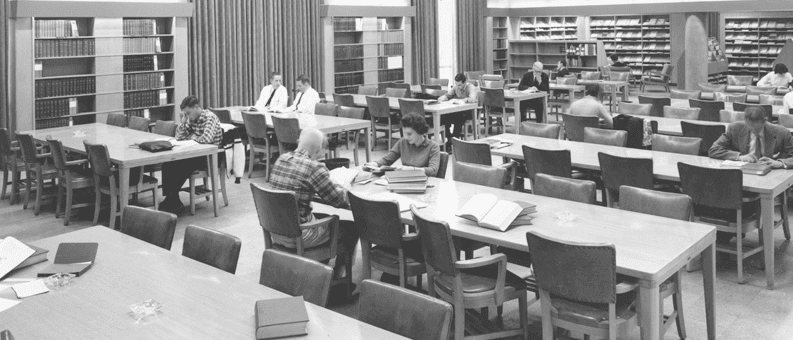History of the Library
The origins of the library date back to 1915, when the Houston Academy of Medicine (HAM) established a small library in downtown Houston to serve the Harris County Medical Society. This Library was combined with the Baylor College of Medicine’s (BCM’s) small library in 1949 to form a centralized collection. As more institutions joined the Texas Medical Center, they also shared the resources of the TMC Library, thereby creating a unique point of collaboration among the institutions of the TMC.
A permanent home for this new library was built in the early 1950s, through the efforts of HAM and BCM. Jesse H. Jones contributed funding for the construction, and in 1954, the approximately 27,000 square foot, three-story “Jesse H. Jones Library Building” was dedicated. By 1975, a new addition to the building had added another 76,000 square feet for the Library’s growing collection. At this time, the Library officially became known as the Houston Academy of Medicine – Texas Medical Center Library. Today we use the shorter operating name of the TMC Library.
During the digital explosion of the 1990s, the Library added our first computer classrooms and a computer lab for users, and carved out space on the first floor to make room for more workstations for students and patrons. After Tropical Storm Allison severely damaged the Library’s street level in 2001, the damage was repaired, the archives were moved to a safer location, and flood walls and gates were added with assistance from FEMA.
In 2004, wireless routers were first added – in spite of the three-foot-thick concrete floors the WiFi continues to be a popular service today. The Library completed a major renovation starting in early 2019 and concluding December 2020. After joining the Joint Library Facility in Bryan, Texas and freeing up extensive space, formerly used to store print books and journals, this project modernized the Library space for independent and collaborative study for the entire Texas Medical Center Community. New furniture, lighting, updated restrooms, and extensive power availability were all part of the modernization project. While the current on-site collection is small, the entirety of the collection is available by request using the Library’s iLLiad request system.

The Role of the Library Today
For millennia, libraries have been fundamental to learning and knowledge. What’s changed is how libraries function in today’s educational environment, both as a place to study and as a place to access accumulated knowledge. In today’s world, libraries are more than book, journal or digital literature storehouses. They are dynamic, interactive environments, with collaborative, open study and learning spaces that foster the sharing of ideas and discoveries.
Today, the TMC Library is a trusted resource that provides expertise and teaches about tools and techniques needed to find and filter relevant, authoritative information from the exponentially growing published literature, to support health sciences research, medical education, and patient care. The TMC Library provides a robust collection of electronic resources including 164 databases, over 70,000 ejournals, and over 370,000 ebooks. Authenticated members can access our collection electronically – anytime, anywhere. The Library is also still an active place to be, as evidenced by the thousands of visitors who walk through the doors each year.
We also remember the past through the John P. McGovern Historical Collections and Research Center at The TMC Library. We hold notable historical collections on the foundations of the medical specialties, Texas medicine, rheumatology, and North American public health. The archival collections focus on the development of the institutions and hospitals in the TMC in Houston, the careers of Houston physicians, and biographical information on Texas physicians. In addition, the archive includes manuscript collections from American rheumatologists and members of the Atomic Bomb Casualty Commission. Most of the Center’s rare books, along with many of the photographs and manuscript collections, have been cataloged and may be found in the Library’s online catalog.
To learn more and become part of the future of the TMC Library, please contact the Executive Director or a liaison librarian for assistance.
